An Overview of Group Reporting in SAP S/4 HANA 1909
SAP S/4 HANA Group Reporting Suite
SAP Group Reporting provides a seamless process between the local and group closing activities since both are in the SAP S/4HANA Core. Both local and group closing activities utilize the same database and user interfaces as well. This speeds up the closing process to provide more time to analyze and act upon the results.
SAP S/4HANA Group Reporting (Financial Consolidation) plays a vital role in providing information to the business. Customers can perform consolidation tasks in real time and also provide a detailed perspective of the business at any point in the period. It also helps in bringing consolidations and planning together in a single application. Companies benefit from accelerated book closing processes.
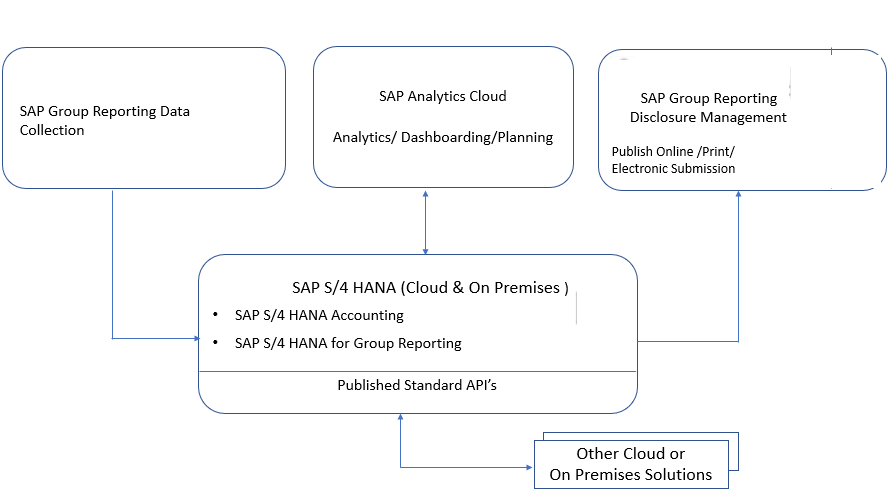
The left side box shows SAP Group Reporting Data Collection Box. It is a cloud-based solution and is available for on-premise and cloud solutions. It helps to access data that is not in S/4HANA and for data Transformation. The Group Reporting Suite has more than a consolidation engine. It is not a legal successor of any existing SAP Consolidation application.
What is the Group Reporting Data Model?
Actual postings are stored in Universal Journal Entry Table: ACDOCA –
Plan data is stored in Plan Data Line Items. : ACDOCP –
SAP Universal Consolidation Journal Entries stored in ACDOCU -.
The data is stored on a periodic basis.
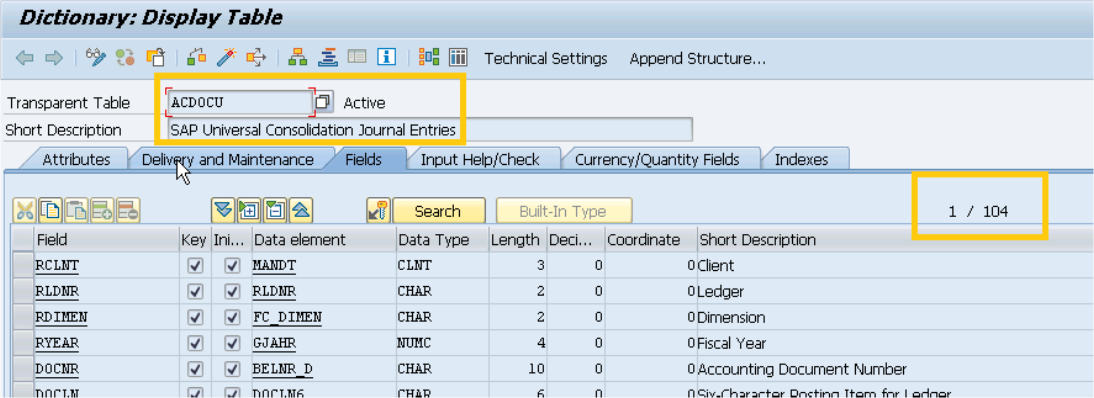
Total Fields in ACDOCU = 104
FINCS* Tables for Group Reporting

How does Group Reporting help?
SAP Group Reporting helps to consolidate Financial Data that is stored in different business units in several systems scattered in different locations. Once the data is collected, customers will be able to do the Consolidation.
“SAP S/4HANA Finance for group reporting” helps users with many of the out-of-the-box features (pre-configured content) for its Customers. They can make their own customizations and configuration settings based on the content delivered by SAP. This content helps customers to accelerate the Group Reporting implementation process. Customers can copy and make changes or will be able to use the content as is. The delivered content includes: , Master data, Consolidation chart of accounts, Mapping of g/l accounts to fs items , Document types, Currency translation methods, elimination(reclassification) methods, Validation methods , Data monitor and Cons monitor task groups SAP Fiori roles, sample Reports, CDS views and queries and so on.
How do Group Reports appear?
Group reports have similar structures as entity wise local reports. The major differences is the data source and displayed currency. Group reports display the data from the perspective of the consolidation group. A Consolidated Balance Sheet Report is provided out of the box.
The following consolidated P&L statements are provided out of the box:
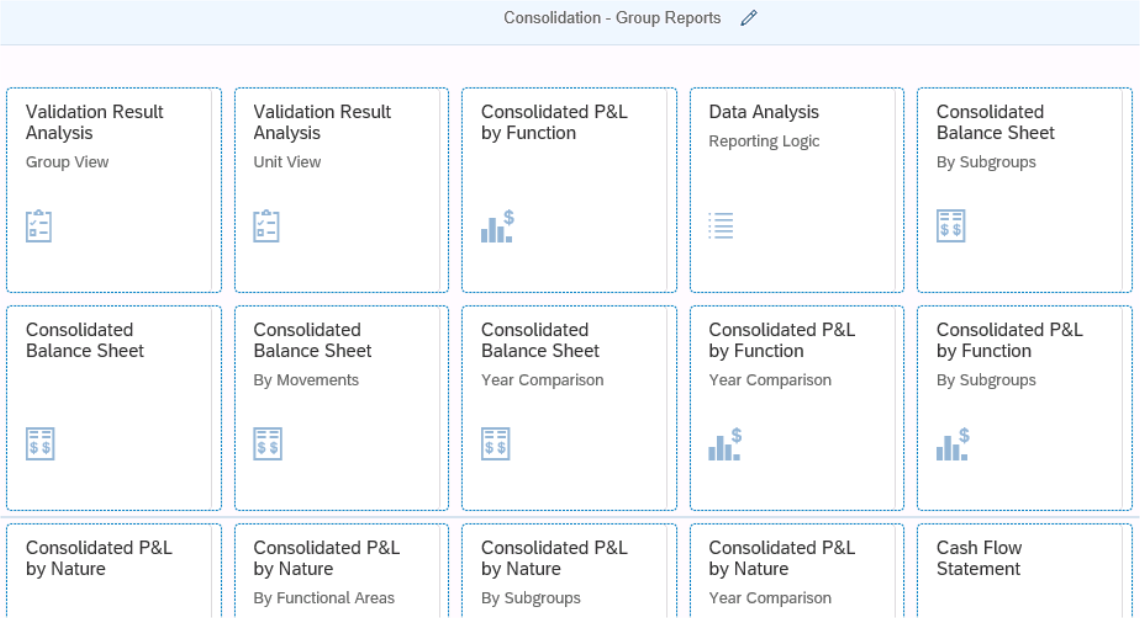
What is the Consolidation Roadmap for SAP S/4HANA Customers?
For SAP S/4HANA customers on 1610 or 1709 BPC RTC is supported alternative.
For SAP S/4HANA 1809 and 1909 SAP S/4HANA Finance for group reporting
For SAP S/4HANA Cloud Customers For SAP S/4HANA cloud for GR is available from 2017 May
Can I get SAP S/4HANA Group Reporting directly after I upgrade my SAP S/4HANA 1610 (or 1709) to 1909?
Per SAP Note 2841647 , New Group Reporting Logic is only activated by default when release 1909 is installed. To activate the New Group Reporting Logic after a system upgrade to 1909 you must open a customer message on SAP Service Marketplace on the FIN-CS-COR-MD component.
How do I implement Group Reporting in SAP S/4HANA?
To implement SAP S/4HANA Finance for group reporting, SAP recommends customers install the SAP Best Practices configuration content — scope item 1SG for the solution. You will get a baseline configuration for SAP S/4HANA Finance for group reporting which customers can adapt to their needs in customizing.

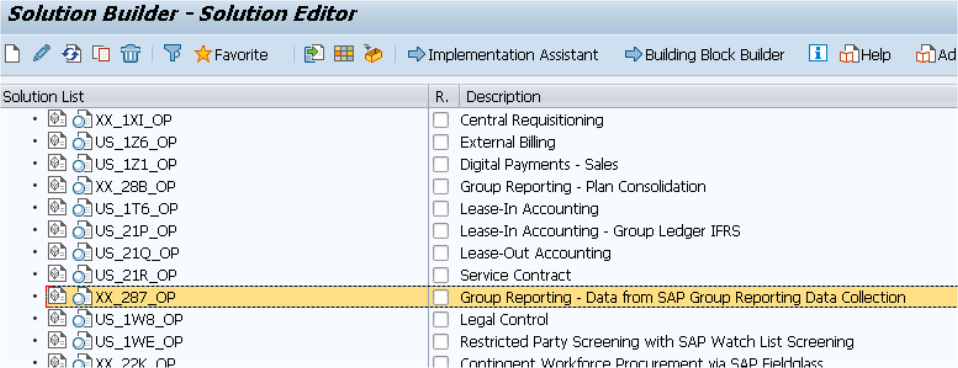


Option 2:
If your customer doesn’t want BP content they can run an initialization program to create the minimum system settings that are needed to use the solution.

To start the initialization program,
IMG > SAP S/4HANA for Group Reporting under Global Settings for Consolidation -> Initialize Settings.

Note: You cannot run the initialization program if you have already installed the BP content
An Overview of the Consolidation Process
Generally, Consolidation process starts with preparatory steps such as setting global parameters > checking the master data of organizational units > financial statement (FS) items > specifying effective exchange rates.

After that, you can proceed with collecting data reported by consolidation units.

Group Reporting uses two monitors:
1. Data Monitor: Local & Consolidation unit relevant tasks.
2. Consolidation Monitor: Group & Consolidation group relevant tasks.Task groups are pre-delivered, and you can create your own.
The monitors are used to:
• Run month-end closing tasks.
• Check the status.
• Ensure a logical sequence and data consistency.
• Provide a one-stop for all closing activities.
The data monitor helps to display the hierarchy of organizational units all the way down to the level of the consolidation units. This means that customers can run the tasks for the consolidation groups as well as the consolidation units.
Data monitor helps to run the activities for collecting and preparing the financial data reported by your consolidation units. These activities are called tasks.
The tasks of the data monitor are predefined and ready to use. The system manages the status of the tasks and thus ensures a logical sequence and consistent data. The tasks of the data monitor are predefined and ready to use.

When the data is ready for consolidation, we open consolidation monitor to perform the consolidation tasks like Inter unit elimination of gross profit, Interunit elimination of other income/expense ,Dividends elimination Interunit elimination of balance sheet, Consolidation of Investments like Investments/equity elimination, Total divestiture etc.

Consolidation Process
In the consolidation phase, the following tasks are to be performed to process data for group reporting purposes:
• Automatic interunit eliminations using the reclassification function
• Manual eliminations
• Manual posting for changes in group shares
• Integration of transaction data into consolidation groups
How do Plan Consolidations work?
Plan consolidations work with SAP Analytics Cloud. It allows customers to prepare and consolidate plan data. Plan consolidation is based on the integration between SAP S/4HANA Finance for group reporting and SAP Analytics Cloud.

Export the planned transaction data to the ACDOCP table to run consolidations. For group reporting, ACDOCU table reads data from the Plan Data Line Items table
On completion of planning, send the plan data to the Plan Data Line Items (ACDOCP) table and make the data available for consolidation. Then Run an end-to-end consolidation process.
Once you have prepared your data, you can run the consolidation process including currency translation, intercompany and investments eliminations, and reporting.
In IMG, we define versions for plan consolidations

Configuration of Group Reporting is a broad subject. In this article I would like to share my experience in some of the configuration points.
1. Assign Roles to your user Id
Most of the SAP S/4HANA Group Reporting activities will be executed using SAP Fiori applications. Consultants and users should have enough and proper roles assigned to their user Ids. By assigning roles and authorizations in SAP Fiori front-end server and back-end systems , they will be able to do it. It also helps to limit the scope of action of individual users in the system. So You have set up the proper authorizations for User ids according to their job responsibilities. Here are some of the SAP delivered roles for your reference.
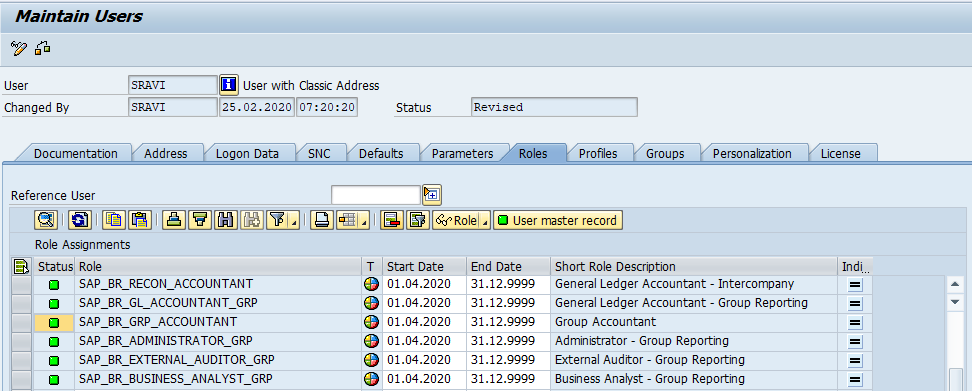
2. Some of the SAP Fiori Applications for SAP S/4HANA Finance for Group Reporting:
Consolidation settings:
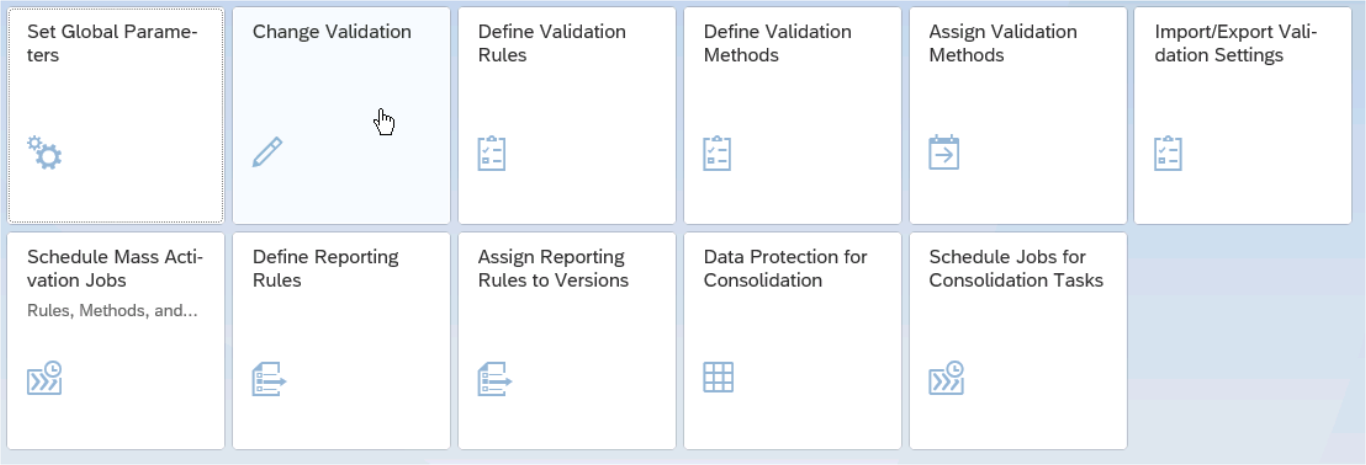
Data Collection apps:

Consolidation Master Data applications

Intercompany Matching Settings:
To define matching rules and methods, maintain variance adjustment workflows, manage teams and responsibilities for workflow scenarios and communication, Below are the Fiori applications
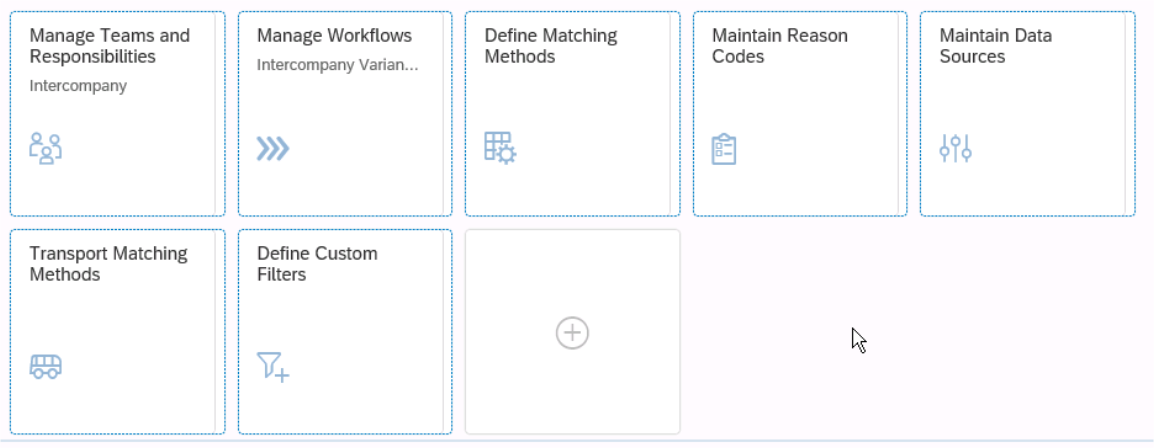
Intercompany Matching operation:
To view or change matching rules and methods, run matching, adjust auto matching results, display matching items, delete documents, schedule matching run jobs and view adjustments postings, below are SAP Fiori Applications
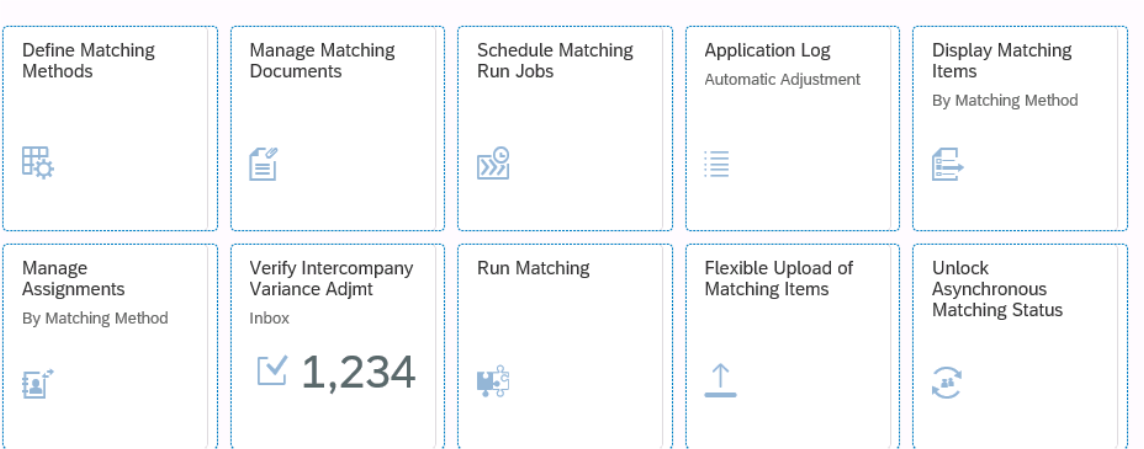
Intercompany reconciliation settings
To define reconciliation cases and to manage organizational unit hierarchies

Intercompany reconciliation operation:
To display overall reconciliation status and reconciliation balance details, adjust auto matching results, to view matching items based on reconciliation case, below SAP Fiori Applications

3. What are the Basic Global System Settings for Group Reporting ?
Global settings are the default settings, that are pre-set. You can see at Transaction code CXE9N
Check Global System Settings
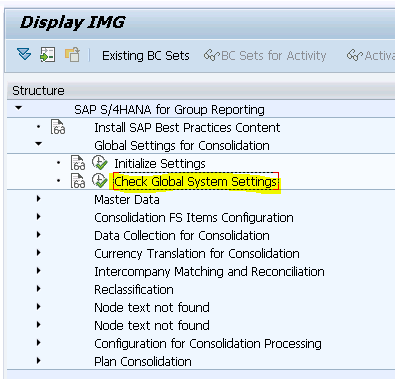
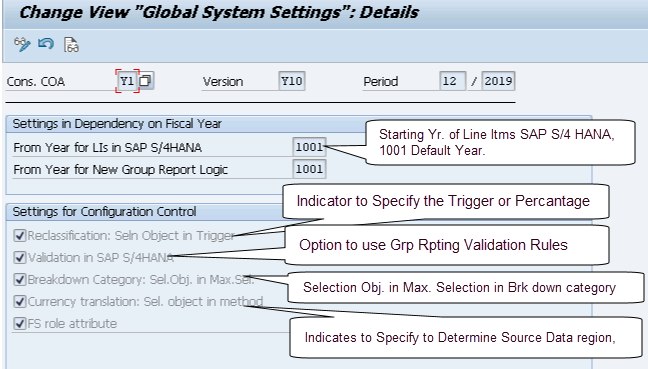
No changes are usually needed for standard settings.
4. Master Data and structures
Do I need to Define Consolidation Ledgers?
To use SAP S/4HANA for group reporting, we have to define consolidation ledgers for storing alternative group currencies and for assigning alternative accounting source ledgers and source currencies. Based on the customers’ requirement, define one or more standard ledgers for consolidation.
If you want to consolidate one consolidation group in USD, and another in EUR, you will need two ledgers – one with ledger currency USD and one with ledger currency EUR.

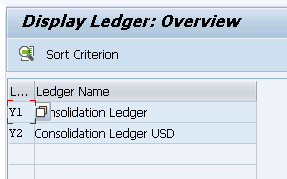
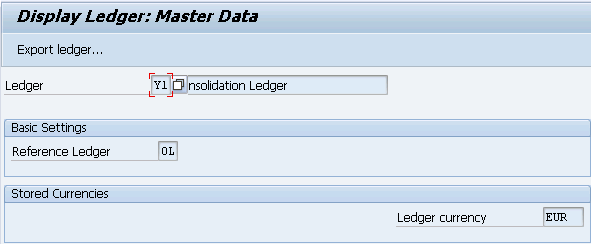
0L : Leading ledger & Ledger Currency is Group Currency
Two ledgers are delivered : Y1 Consolidation Ledger & Y2 Consolidation Ledger USD
Multiple ledgers are needed for multiple currencies ( 1:1)
If you want to define your own ledger, you can define do so. It must start with the letter C, otherwise you will receive the below error.

How does data post to Consolidation ledger?
There are different ways. One of them is when users release the data from ACDOCA , Consolidation Ledger Updates ACDOCU table; See below Ledger Y1 updated.

What is Consolidation Dimension?
The consolidation dimension is a configuration object. The delivered dimension = Y1 (company).

Versions
Version is Category. ( Plan / Actual )
The main delivered version is Y10.
Setting for Plan Consolidation:

The below is the example for Plan Consolidation version

How do we define Consolidation Chart of Accounts?
Y1 is the delivered Consolidation chart of accounts

The maximum length is 10 characters.
The Consolidation chart of accounts contains FS Items. When FS item is double-clicked we will be able to see attributes of the FS Item. (Example : Asset Account, Etc)
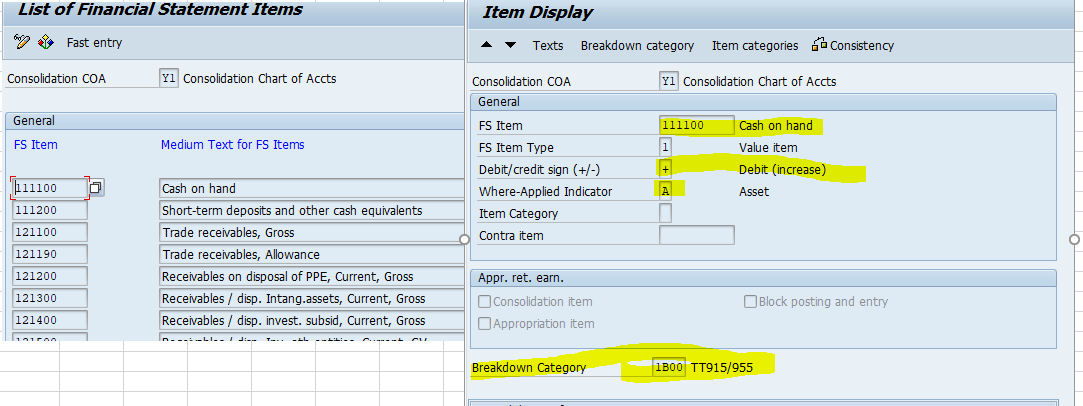
Customers can create their own COA or modify FS Items in Y1.
On the SAP Fiori launchpad “Manage Global Accounting Hierarchies” can be seen.
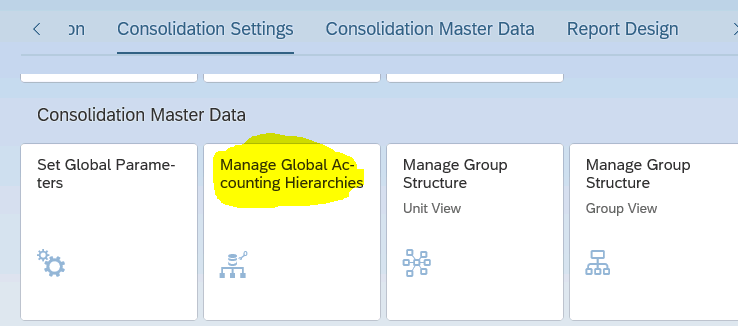
In this Fiori app, you can see that FS items are managed as hierarchies like Assets and Liabilities and can also see Breakdown Categories.
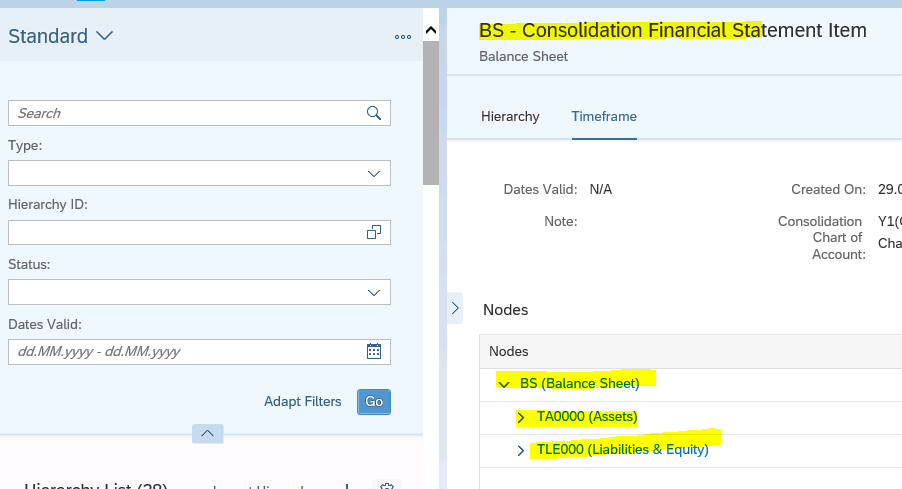
Manage breakdown categories and subitems
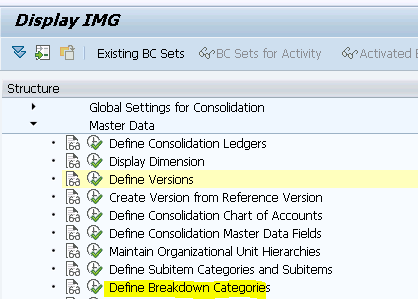
Breakdown categories (BDC) are used to control subitem and other subassignments for transactional data.

Please Note : When fs items are uploaded, the breakdown categories are included. If in any case, a breakdown needs to change, the fs item file needs to be uploaded again.
Every FS item is assigned to a Breakdown category. You can see this below.
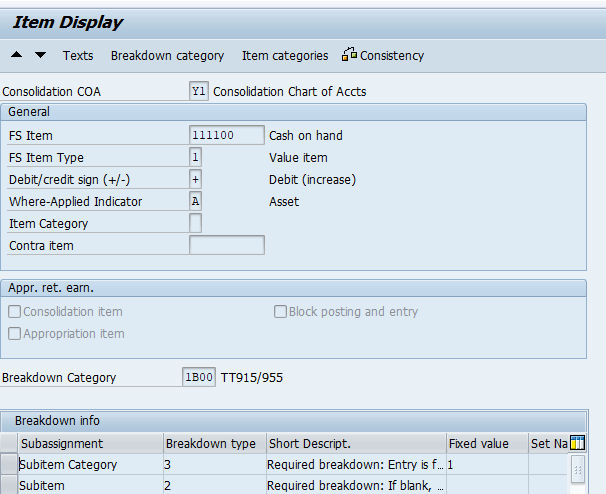
Each breakdown category refers to one chart of accounts, version, and period
5. How to Configure the Data Monitor
Configuration and Setting up the Data Monitor is a pre-requisite. By installing Best Practice Content you can make changes wherever needed as per the customer’s requirements.
Once we configure Data Monitor we have different options of collecting the data for consolidation. Here, I am just specifying two options.
1. Releasing Data
2. Uploading Reported Financial Data
3. Post Group Journal entries
4. APIs ( import and update)
Global Parameters.: CXGP

Following are some of the Basic Configuration steps in SPRO
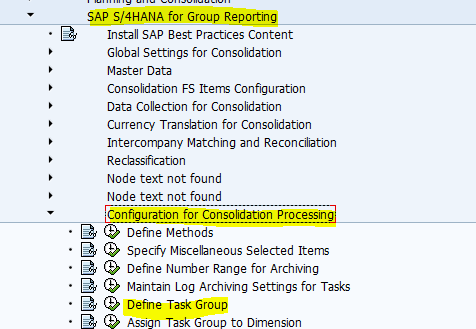
The data monitor depends on a task list and an organizational structure.
The tasks of the data monitor are predefined. S10 and S20 are delivered Task Groups
We will assign tasks to the Task Group, and then Assign Task Group to Dimension

Data monitor view is by default display based on task group configuration of the above screen. See left side Data monitor and right side Tasks in the Task Group.

For every task, the preceding task is to be specified as shown below. Task 1020 is the preceding task for 1030. Similarly, for other tasks the preceding tasks are to be specified.

The data monitor tasks are defined here

Data Monitor: CXCD

You can also see data monitor in SAP Fiori App in Consolidation Data Preparation Group.


Once Data Monitor Related configuration is completed the User will be able to release SAP S/4HANA Data for Consolidation (ACDOCU).
How Do I release Financial Accounting Data to ACDOCU?
Users have to release new postings from ACDOCA to SAP S/4HANA Finance for group reporting (ACDOCU). This control mechanism prevents unwanted data from becoming available to group reporting. To be able to release, the period should be open
Example for Manual release
Post a document using FB50

Then Data Release from Universal Journal.
Go to Data Monitor CXCD > Select the Unit from which you want to release the data to ACDOCU and click on update run

Then select the row and click on Reported financial data

Then save it

You can see the status

We will be able to see an update like below:

Important Points:
1. We can release Financial Documents from ACDOCA multiple times in the current period.
2. Once period closing is done, data release should be run for the last time for that period. Then you can block the task.
3. When transferring financial data from ACDOCA to group reporting , the system derives the posting period based on the accounting posting date and the period definition of the assigned to the Fiscal Year variant.
4. You can only release data from the accounting period that corresponds to the consolidation period in which the release task is executed, provided that the accounting period is still open.
Once Data is Released from ACDOCA to ACDOCU you will be able to see in the Consolidation Balance sheet.
Can I delete the data released from ACDOCA to ACDCOU?
You cannot delete the data.
Open app Balance Sheet by Consolidation units
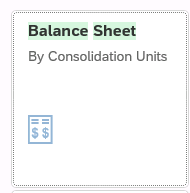
Method 2: Uploading Financial Accounting Data using Flat files (Flexible Upload)
In my experience, this method is quick and easy. You will be able to import periodic data or year-to-date data. You can import for one period or for multiple periods and you can also import for one or multiple consolidation units.
Please find file format below from SAP Note 2659672
Steps:
1. Use the attached flexible upload template file from SAP Note 2659672 and replace the example figures in row 10 with your own data.
2. Then access the Flexible Upload of Reported Financial Data app or GUI Transaction code. Then select the upload method SRD1 (with Tab as the field separator) or SRD2 (with semicolon as the field separator), and select the Excel file in Physical File Name.
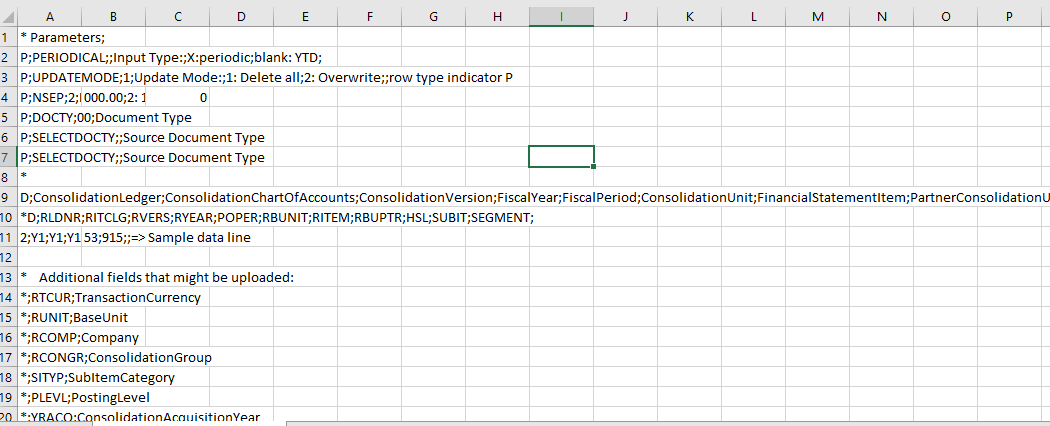

Once file is ready go to transaction code CX25 or SAP Fiori app
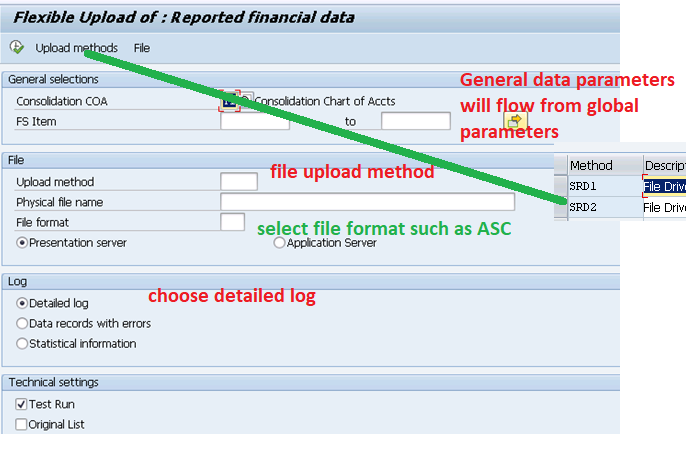
Before you upload the file ensure all the periods are open as per file data. Unblock the task data entry for all the periods and respective consolidation unit.
If you have new data the file can be imported again. There are delete and overwrite modes – use the correct option as per your business need.
This flex file upload uses posting level 00 and document type 00

3. APIs to transfer financial data to SAP S/4HANA Finance for group reporting.
One of the options to update ACDOCU is API.
To set up APIs, see the set-up guide attached to the SAP Note 2659672
Please find below IMG for configuration
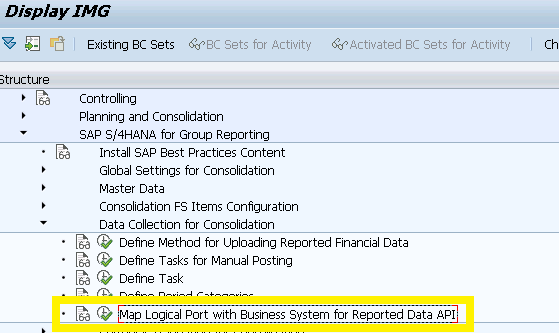
With this, customers can import Financial Accounting data of one or multiple consolidation units to the SAP S/4HANA system.
Customers can configure API using the below

The API will appear when Data collection is run from the data monitor6 Data Validation
6. How to check integrity of the Financial Accounting Data to be moved to ACDOCU
Example of Accounting Document:
Debit : Cash Account
Credit : Revenue Account
Validation of Universal Journal checks if errors exist in universal journals in the form of missing or incorrect sub-assignments for fs items
Validation of Universal Journal will also detect out-of-balances.
If there are any missing mappings between GL accounts and FS items, during data release it throws an error.
For this, customers have to create validation rules.

We create a Rule as shown below
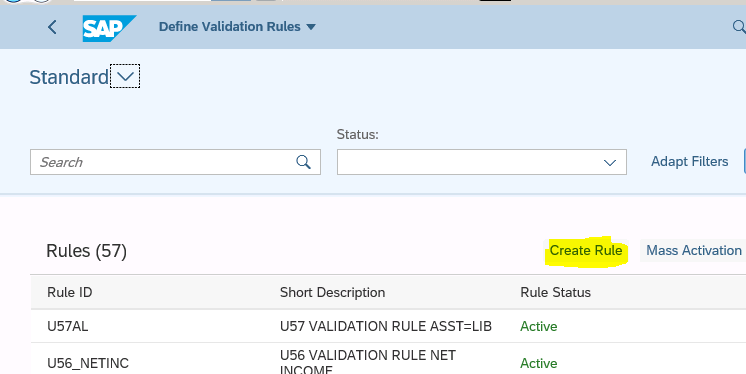
After giving Rule ID and other rule attributes like below, we will save the Validation rule

Then, Validation Method is to be created using Define Validation methods app

Then, Assign Validation method to Consolidation Unit using Assign Validation methods App.
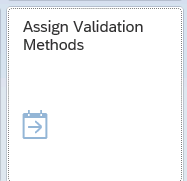
Then Assign Validation task to the Task Group
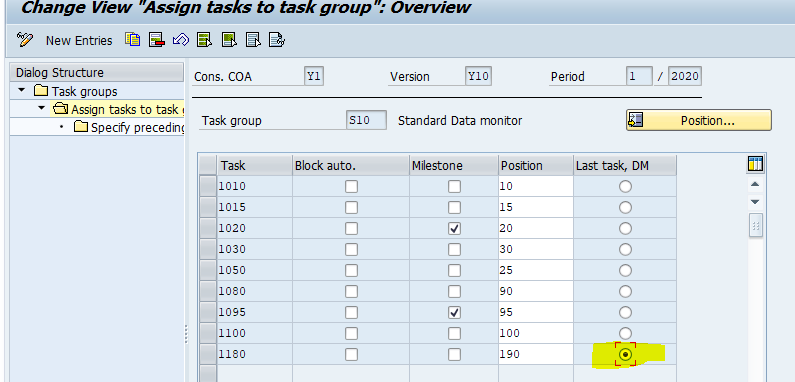
Conclusions:
SAP S/4HANA Finance for Group Reporting customers have to know the important pre-requisites for the implementation of the Group Reporting in SAP S/4HANA from Experienced Group Reporting Consultants. Consultants working on this will demonstrate different aspects and methods in data collection such as Manual Release, Flexible file uploads etc and will let their customers know General Points, Validation points, Analytics Etc. Group reporting provides a seamless process between the local and group closing activities and helps in completing the consolidation process.
About the Author:
Dr. Ravi Surya Subrahmanyam is a technical and financials writer with a background in SAP Financial Accounting, Funds Management, Financial Supply Chain Management, Cash Management & in-house cash, SAP S/4 HANA Finance, RAR etc. He has been working as a Director for the SAP Practice for the Hackett group India Ltd, GDC- India. He completed his Master’s degree in Finance from Central University, Master of Commerce from Osmania University, Master of Commerce from Andhra University, and Ph.D.in Finance from one of the best universities in India. His research papers have been published in national and international magazines. He has been a Visiting Instructor for SAP India Education and SAP Indonesia – Education. He has been working on Conversion and Upgradation projects and is a Certified Solution Architect for SAP S/4 HANA and an SAP S/4 HANA Certified Professional. He can be reached at sravi@answerthink.com
Stay tuned for more insights on Eursap’s Blog…
Need to hire SAP resources for remote work?
Get in touch with Eursap – Europe’s Specialist SAP Recruitment Agency
